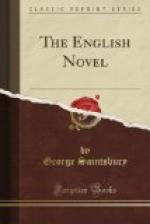This remarkable pair may be supplemented by an in some ways more remarkable trio, all of them pretty close contemporaries, but, for different reasons in each case, coming rather late into the novel field—Charles Reade (b. 1814), Anthony Trollope (b. 1815), and Mary Ann Evans (b. 1819). It would be difficult to find three persons more different in temperament; impossible to find more striking instances of the way in which the new blend of romance and novel lent itself to the most various uses and developments. Reade—who thought himself a dramatist and wasted upon drama a great deal of energy and an almost ideal position as a possessor of an unusually rich fellowship at Magdalen College, Oxford, with no duties—came rather closer to Dickens than to any novelist previously named, not merely in a sort of non-poetic but powerful imagination, but also in the mania for attacking what seemed to him abuses—in lunatic asylums (on which point he was very nearly a monomaniac himself), prisons, and many other things. But he is almost more noteworthy, from our point of view, because of his use—it also must, one fears, be called an abuse—of a process obviously invited by the new demand for truth to life, and profitable up to a certain point. This was the collection, in enormous scrapbooks, of newspaper cuttings on a vast variety of subjects, to be worked up into fiction when the opportunity served. Reade had so much genius—he had perhaps the most, in a curious rather incalculable fashion, of the whole group—that he very nearly succeeded in digesting these “marine stores” of detail and document into real books. But he did not always, and could not always, quite do it: and he remains, with Zola, the chief example of the danger of working at your subject too much as if you were getting up a brief, or preparing an article for an encyclopedia. Still, his greatest books, which are probably It is Never too Late to Mend (1856) and The Cloister and the Hearth (1861), have immense vigour and, in the second case, an almost poetic attraction which Dickens never reaches, while over all sparks and veins of genius are scattered. Moreover, he is interesting because, until his own time, he would have been quite impossible; and, even at that time, without the general movement which we are describing, very unlikely.
There is not so much object here in discussing the much discussed question of the merits and defects of “George Eliot” (Mary Ann Evans or Mrs. Cross) as a novelist, as there is in pointing out her relations to this general movement. She began late, and almost accidentally; and there is less unity in her general work than in some others here mentioned. Her earliest and perhaps, in adjusted and “reduced” judgments, her best work—Scenes of Clerical Life (1857-1858), Adam Bede (1859), The Mill on the Floss (1860), Silas Marner (1861)—consists of very carefully observed and skilfully rendered studies of country life and




